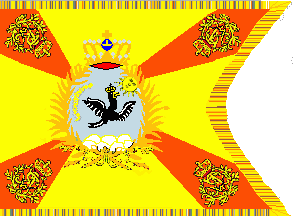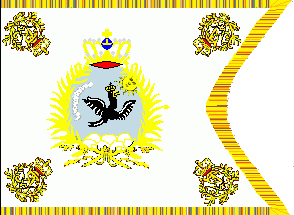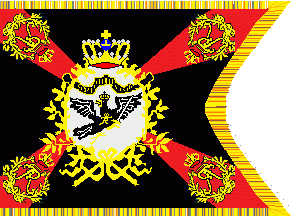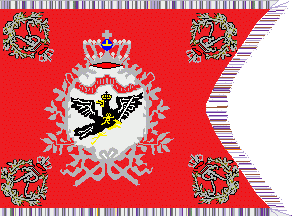
2nd Dragoons Regiment Colours
|
2nd Dragoons Regiment of Pferde
Although the 2nd Dragoons was raised as an independent regiment in 1725, parts of it had existed as elements of other fighting units during the Franco-Dutch War in 1696, and the Spanish War of Succession in Flanders (1706-1709). These predecessors saw action in the Battle of Oudenarde and the Battle of Malplaquet during that time.
After becoming an independent regiment in 1725, the 2nd Dragoons were garrisoned mainly in Lüben and Bunzlau. Their first commander was Colonel Friedrich Otto Frhr von Sonsfeld , who was later followed by notable commanders such as Colonel Louis Prince of Württemberg in 1749; Major General Reimar Schwerin in 1754; Major-General Christian Friedrich von Blanckensee in 1757; Colonel Anton von Krockow in 1778; the Prince of Württemberg, in 1781; and Colonel Johann Christoph von Milling until 1790. The unit served in both Silesian Wars, the War of Austrian Succession, the Seven Years' War, and the War of Bavarian Succession under Frederick the Great.
|

3rd Dragoons Regiment Colours
|
3rd Dragoons Regiment of Pferde
The 3rd Dragoons Regiment was first raised as a new regiment of eight companies, in four cornets, in 1704, and was garrisoned in Küstrin. Its first Commander was Major General Friedrich von Derfflinger in 1704, followed by Colonel Adolf Friedrich von Schulenburg in 1724; Colonel Friedrich Rudolf Graf von Rothenburg in 1741; Baron von Schönaich in 1753; Count of Waldburg in 1753; Major General Peter von Meinicke in 1757; Major General Kurt Friedrich von Flanss in 1761; Oberst Achaz Heinrich von Alvensleben in 1763; Alvensleben, Major General Otto Balthasar von Thun in 1777; Major General Georg Ludwig von Gilsa in 1788; Major General von Prittwitz, Wolf, Moritz in 1792; Major General Hans Carl Strantz in 1797; and Colonel Friedrich Wilhelm von Irving in 1800.
It served under Friedrich the Great during the First Silesian War (1740-1742), the War of the Austrian Succession (1740-1748), the Second Silesian War (1744-1745), the Seven Years' War (1756-1763), the War of the Bavarian Succession in 1778, and during Frederick the Great's most notable and decisive military victories on the battlefield. |

8th Dragoons Regiment Colours
|
8th Dragoons Regiment
The 8th Dragoons Regiment was raised in 1744, and garrisoned in Magdeburg and Insterburg. Its Commanders: were first Stosch until 1751, the Langermann until 1757, Platen until 1758, Alt-Platen until 1770, and Platen until 1787.
The 8th Dragoons Regiment experienced its first combat as a regiment at the Battle of Kesselsdorf in 1745, against the combined forces of Austria and Saxony during the part of the War of the Austrian Succession known as the Second Silesian War. The 8th Dragoons Regiment was on the left wing in the first bloody meeting in the impassable Zschoner-Bach stream before Zöllmen, a village in the West of the Saxon capital of Dresden. Their losses were small in contrast to the losses of the infantry on both sides.
During the Seven Years' War, they participated in the battles of Zorndorf and Kunersdorf. At Zorndorf, they attacked as a reserve behind the left wing of Zorndorf in the great attack from Seydlitz and showed great bravery. Taken in flank and front the whole enemy wing was defeated. The 8th Dragoons Regiment also fought in the Reserve Corps L'Estocq (2nd Hussar Regiment) at both Thorn and Soldau, and in 1807 in the Battle of Braunsberg and the Battle of Königsberg during the Napoleonic Wars. |

12th Dragoons Regiment Colours
|
12th Dragoons Regiment
The 12th Dragoons transferred from Württemberg service in 1742, and were garrisoned in Treptow and Wollin. Its first commander was Friedrich Eugen, the Duke of Württemberg, until 1749, Prinz Eugen von Württemberg until 1769, Reitzenstein until 1780, and Kalckreuth until 1793.
The unit was incorporated into the Prussian army on September 28, 1741, as a dragoon regiment. It had existed since 1734, but was in the Württemberg service as a cuirassier regiment designated as "Kürassier-Regiment Duchess Marie Auguste." At the beginning of the Seven Years' War, the regiment consisted of 5 squadrons. During the Seven Years’ War the regiment fought at the Battles of Kolin, Breslau, Leuthen, Kunersdorf, Landeshut, and Liegnitz.
The long history of the 12th Dragoons ended in the Napoleonic campaigns that included the decisive Battle of Jena-Auerstedt in 1806. It was disbanded in 1806, after the capitulation of Ratekau.
|